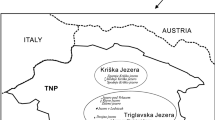Abstract
Community structure of zoohydrobionts in the lake affected by chemical weapon destruction was studied for the first time. Low pH favored species specific to acidic water bodies as well as bidominant zooplankton community. The long-term effects of chemical pollution determined the stage of community succession, namely, the absence of the key predator (fishes), abundance of detritus consumers in the zoobenthic community (dipteran larvae), diversity of amphibiotic insects, and low species diversity in the zooplankton community with the prevalence of cladocerans and rotifers. Unbalanced composition of higher trophic levels results in an unstable functioning of the lake and accumulation of significant amounts of detritus, which is utilized by the abundant microzoobenthic component of the ecosystem.
Similar content being viewed by others
References
Andronikova, I.N., Strukturno-funktsional’naya organizatsiya zooplanktona ozernykh ekosistem (Structural and Functional Organization of Zooplankton in Lake Ecosystems of Different Trophic Status), St. Petersburg: Nauka, 1996.
Blinokhvatov, A.F., Ivanov, A.I., and Pankratov, V.M., Gidrokhimicheskaya kharakteristika ozera Mokhovoe, in Mater. mezhdunar. konf. “Ekologicheskie problemy naslediya “kholodnoi voiny” i puti ikh preodoleniya” (Ecological Problems and Pathways to Overcome Cold War Consequences) Pensa, 2004, pp. 6–15.
Chistyakova, A.A. and Kulikovskii, M.S., Vegetation of Peat Bogs in the Pnza Region and Its Anthropogenic Dynamics, in Mater. Mezhdunar. nauch.-prakt. konf. “Problemy okhrany prirodnykh landshaftov i bioraznoobraziya Rossii i sopredel’nykh stran” (Proc. Scientific and Applied Int. Conf. “Problems of Natural Landscape Conservation and Biodiversity in Russia and Neighboring Countries”), Pensa, 2004a, pp. 131–134.
Chistyakova, A.A. and Kulikovskii, M.S., Effect of Chemical Pollution on the Algal Flora in the Mokhovoe Lake, in Mater. mezhdar. konf. “Ekologicheskie problemy naslediya “kholodnoi voiny” i puti ikh preodoleniya” (Ecological Problems and Pathways to Overcome Cold War Consequences), Pensa, 2004b, pp. 85–88.
Chistyakova, A.A. and Stoiko, T.G., Specific Trophic Links in the Krugloe Lake (Penza Region), in Tez. dokl. Mezhdunar. konf. “Ekologicheskie problemy basseinov krupnykh rek” (Proc. Int. Conf. “Environmental Issues of Large River Basins”) Tolyatti, 2003, p. 308.
Dokturovskii, V.S., Peat Bogs in the Penza Province (Based on Nature Reserve Data), Tr. po izucheniyu zapovednikov, 1925, no. 3, pp. 1–15.
Golubkov, S.M., Role of Predation in Animal Evolution: Effect of Fish of the Structure of Taxocenosis in Evolution of Aquatic Insects, Usp. Sovrem. Biol., 2000, vol. 120, no. 5, pp. 441–451.
Ivanov, A.I. and Chistyakova, A.A., Effect of Chemical Pollution on the Moss and Vascular Plant Flora in the Mokhovoe Lake, in Mater. mezhdunar. konf. “Ekologicheskie problemy naslediya “kholodnoi voiny” i puti ikh preodoleniya” (Ecological Problems and Pathways to Overcome Cold War Consequences) Pensa, 2004, pp. 44–51.
Lazareva, V.I., Transformation of Zooplankton Communities in Small Lakes after Acidification, in Struktura i funktsionirovanie ekosistem atsidnykh ozer (Structure and Functioning of Acidic Lake Ecosystems), St. Petersburg: Nauka, 1994, pp. 150–169.
Makarchenko, E.A., Midges Chironomidae, in Opredelitel’ presnovodnykh bespozvonochnykh Rossii i sopredel’nykh territorii. T. 4. Vysshie nasekomye. Dvukrylye (Key to Freshwater Invertebrates of Russia and Neighboring Countries. Vol. 4. Higher Insects. Dipterans), St. Petersburg, 1999, pp. 210–295.
Meire, P. and Dereu, J., Use of the Abundance/Biomass Comparison Method for Detecting Environmental Stress: Some Considerations Based on Intertidal Macrozoobenthos and Bird Communities, J. Appl. Ecol., 1990, vol. 27, pp. 703–717.
Pankratov, V.M. and Mishanin, S.I., Obsledovanie mest proshlogo unichtozheniya khimicheskogo oruzhiya na territorii Penzenskoi oblasti (Examination of Sites of Past Destruction of Welfare Agents in the Penza Region), Moscow: Agentstvo Rakurs, 1999.
Raup, D. and Crick, R.E., Measurement of Faunal Similarity in Paleontology, J. Paleontol., 1979, vol. 53, pp. 1213–1227.
Schönborn, W., Testaceen als Bioindikatoren im System der Seentypen. Untersuchungen in Masurischen Seen und im Suwalki-Gebiet (Polen), Limnologica, 1966, vol. 4, pp. 1–11.
Skal’skaya, I.A., Zooperifiton Vodoemov Basseina Verkhnei Volgi. Rybinsk (Zooperiphyton of the Upper Volga Basin) 2002.
Sprygin, I.I., Materialy k poznaniyu Srednego Povolzh’ya (Data for Studies in the Middle Volga Region), Moscow: Nauka, 1986.
Stoiko, T.G. and Mazei, Yu.A., Biodiversity of Aquatic Biocenoses as a Prerequisite for the Maintenance of Regional Plankton Biodiversity, in Mater. mezhdunar. konf. “Prirodnoe nasledie Rossii: izuchenie, monitoring, okhrana” (Proc. Int. Conf. “Natural Heritage of Russia: Studies, Monitoring, and Conservation) Tolyatti, 2004, pp. 259–260.
Stoiko, T.G. and Mazei, Yu.A., Zooplankton of Above-Flood-plain Water Bodies in the Basins of the Sura and Moksha Rivers, in Mater. mezhdunar. soveshch. “Bioresursy i bioraznoobrazie ekosistem Povolzh’ya: proshloe, nastoyashchee, budushchee” (Proc. Int. Conf. “Bioresources and Biodiversity of Ecosystems in the Volga Region: Past, Present, and Future), Saratov: Sarat. un-t, 2005a, pp. 232–234.
Stoiko, T.G. and Mazei, Yu.A., Zooplankton Community Structure in the Bol’shoe Mokhovoe Lake, in Mater. Vseros. nauch.-prakt. konf. “Okhrana biologicheskogo raznoobraziya i razvitie okhotnich’ego khozyaistva Rossii” (Proc. All-Russia Scientific and Applied Conf. “Biodiversity Conservation and Development of Hunting Industry”), Pensa: PGSKhA, 2005b, pp. 70–72.
Tikhonenkov, D.V. and Mazei, Yu.A., First Data on the Fauna of Heterotrophic Flagellates in Water Bodies of the Sura River Basin, Vestn. molodykh uchenykh PGPU im. V.G. Belinskogo, 2005.
Vandysh, O.I., Effect of Acidification on Zooplankton Communities of Small Lakes in Mountain Tundra, Vodn. Resur., 2002, vol. 29, no. 5, pp. 602–609.
Warwick, R., Pearson, R., and Ruswahyuni, A., Detection of Pollution Effects on Marine Macrobenthos: Further Evaluation of the Species Abundance/Biomass Method, Mar. Biol., 1987, vol. 95, pp. 193–200.
Zhivodrova, S.A., Pankratov, V.M., and Antoshin, A.E., Mysh’yak v prirodnykh sredakh i tokiskologiya mysh’yaka (Arsenic in Natural Environment and Its Toxicology), Moscow: Agentstvo Rakurs, 2000.
Author information
Authors and Affiliations
Additional information
Original Russian Text © T.G. Stoiko, Yu.A. Mazei, A.N. Tsyganov, D.V. Teekhonenkov, 2006, published in Izvestiya Akademii Nauk, Seriya Biologicheskaya, 2006, No. 2, pp. 225–231.
Rights and permissions
About this article
Cite this article
Stoiko, T.G., Mazei, Y.A., Tsyganov, A.N. et al. Impact of chemical weapon destruction on the structure of lake zoohydrobiont community. Biol Bull Russ Acad Sci 33, 179–184 (2006). https://doi.org/10.1134/S1062359006020130
Received:
Issue Date:
DOI: https://doi.org/10.1134/S1062359006020130




